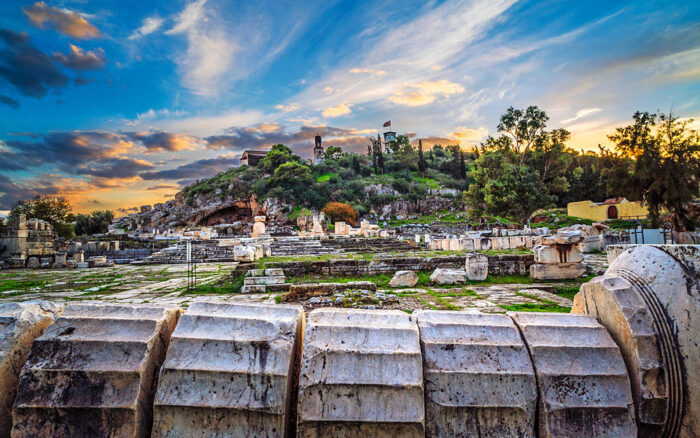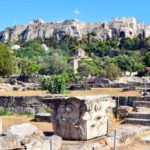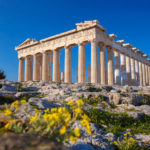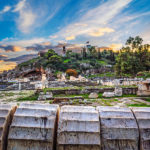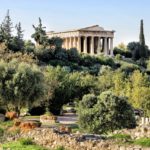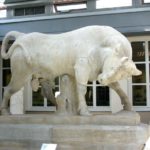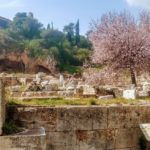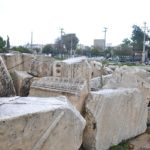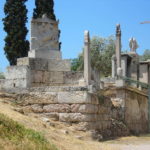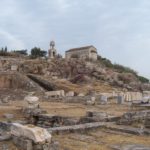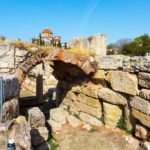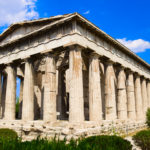8 Ηours
Private Tour
English
Up to 14 Guests
On the steps of Mysticism Private tour
Got a Question?
Contact UsHighlights
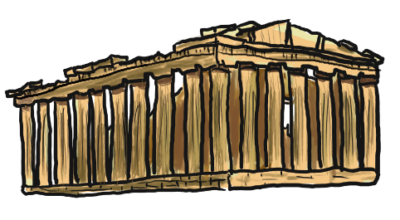
Ancient Greek Mysteries private tour
- Acropolis – Propylaea – Parthenon – Erechtheion – Temple of Athena Nike
- Ancient Agora of Athens – Temple of Hephaestus – Museum of the Ancient Agora
- Kerameikos
- Iera Odos / Sacred Way
- Archaeological Site and Museum of Eleusis
Itinerary
Feel like an ancient mystic who wants to be illuminated and learn the secrets of the afterlife.
Sightseeing in Athens starts with the hill of Acropolis which will make your day. On the historical hill, you will have the opportunity to see the Odeon of Herodes Atticus, the Temple of the Athena Nike, the monumental gateway (Propylaea), the Erechtheum and of course the famous Parthenon, the main temple dedicated to the virgin goddess Athena. The ritual started at the foothills of the Acropolis.
Then, we will visit the Ancient Greek Agora which is considered the birthplace of democracy, philosophy and free speech. In the ancient Greek Agora, you will visit the Temple of Hephaestus (the best-preserved temple in Greece standing largely as built) and a small museum house under the Portico of Attalos. We will follow the way from the Agora to the Poikili Stoa, outside of the archaeological site where the pilgrims gathered on the first day.
After that we will head to the Kerameikos Archaeological Site that was named after the community of the potters (kerameis) who occupied the whole area along the banks of the river Eridanos. The walls of Athens, which were constructed in the 5th century BC by Themistocles, divided the area into two sections, the “inner” and “outer” Kerameikos. The wall had two monumental gates, Dipylon and the Sacred Gate, placed at the outset of the two most important processional roads of Athens, the Panathenaic Way which led to the Acropolis, and the Sacred Way which led to Eleusis. Nearby is the Dipylon gate which was the main entrance to the city, where the Panathenaic procession began and where the prostitutes congregated so they could make themselves available to weary travelers. Between the two gates is the Pompeion, where the preparations were made for the Panathenaic procession which was in honor of Athena. We will start our way to Eleusis from the Sacred Gate.
We will cross Iera Odos / Sacred Way, built on the ancient one while on our way we will have a brief stop to see some of its remains by the modern street before we arrive to Eleusina. There we will follow the same way, from the propylaea to the Telesterion to get initiated to the secret mysteries. Visit the famous sanctuary and its museum and learn more about the most famous religious rites of ancient Greece.
Inclusions - Exclusions
Private Tours are personal and flexible just for you and your party.
Inclusions:
-
Professional Drivers with Deep knowledge of history [Not licensed to accompany you in any site]
-
Hotel pickup and drop-off
-
Transport by private vehicle
- Bottled water
Exclusions:
- Entrance Fees [70€ for over 18 yo for Non-EU & 25 yo for EU Citizens]
- Licensed Tour guide upon request depending on availability [Additional cost – 380 €]
- Airport Pick Up and drop-off (Additional cost)
- Lunch
Entrance Fees
ADMISSION FEES FOR SITES:
Summer Period: 70€ per person
(1 April – 31 October)
Acropolis: 30€ (08:00am- 20:00pm)
Ancient Agora: 20€ (08:00am- 20:00pm)
Kerameikos: 10€ (08:00am – 19:30pm)
Eleusina: 10€ (08:00am – 19:30pm, Tuesday closed)
Winter Period: 70€ per person
(1 November – 31 March)
Acropolis: 30€ (08:00am- 17:00pm)
Ancient Agora: 20€ (08:00am- 17:00pm)
Kerameikos: 10€ (08:00am– 17:00pm)
Eleusina: 10€ (08:00am – 15:30pm, Tuesday closed)
Free admission days:
- 6 March (in memory of Melina Mercouri)
- 18 April (International Monuments Day)
- 18 May (International Museums Day)
- The last weekend of September annually (European Heritage Days)
- Every first and third Sunday from November 1st to March 31st
- 28 October
Holidays:
- 1 January: closed
- 25 March: closed
- 1 May: closed
- Easter Sunday: closed
- 25 December: closed
- 26 December: closed
Free admission for:
- Children & young people up to the age of 25 from EU Member- States
- Children & young people from up to the age of 18 from Non- European Union countries
- Persons over 25 years, being in secondary education & vocational schools from EU Member- States
- Escorting teachers during the visits of schools & institutions of Primary, Secondary & Tertiary education from EU Member- States
- People entitled to Social Solidarity income & members depending on them
- Persons with disabilities & one escort (only in the case of 67% disability)
- Refugees
- Official guests of the Greek State
- Members of ICOM & ICOMOS
- Members of societies & Associations of friends of State Museums & Archaeological sites
- Scientists licensed for photographing, studying, designing or publishing antiquities
- Journalists
- Holders of a 3- year Free Entry Pass
Reduced admission for:
- Senior citizens over 65 from Greece or other EU member-states, during
the period from 1st of October to 31st of May - Parents accompanying primary education schools visits from EU Member- States
- Escorting teachers of educational visits of schools & institutions of primary, secondary & tertiary education from non European Union countries
Reduced & free entrance only upon presentation of the required documents
History
Acropolis:
The Acropolis hill (acro – edge, polis – city), so-called the “Sacred Rock” of Athens, is the most important site of the city and constitutes one of the most recognizable monuments of the world. It is the most significant reference point of ancient Greek culture, as well as the symbol of the city of Athens itself as it represents the apogee of artistic development in the 5th century BCE. During Perikles’ Golden Age, ancient Greek civilization was represented in an ideal way on the hill and some of the architectural masterpieces of the period were erected on its ground.
Propylaea:
The Propylaea is the monumental entrances to the sacred area dedicated to Athena, the patron goddess of the city. Built by the architect Mnesicles with Pentelic marble, their design was avant-garde. To the south-west of the Propylaea, on a rampart protecting the main entrance to the Acropolis, is the Ionian temple of Apteros Nike or Wingless Victory.
Parthenon: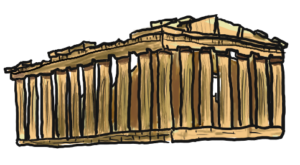
The Parthenon is the most important and characteristic monument of the ancient Greek civilization and still remains its international symbol. It was dedicated to Athena Parthenos (the Virgin), the patron goddess of Athens. The first temple was destroyed by the Persian in 480 BC, so the new one was built between 447 and 438 B.C.E. and its sculptural decoration was completed in 432 B.C.E. The construction of the monument was initiated by Perikles, the supervisor of the whole work was Pheidias, the famous Athenian sculptor, while Iktinos (or Ictinus) and Kallikrates (Callicrates) were the architects of the building. The temple is built in the Doric order and almost exclusively of Pentelic marble. It is peripheral, with eight columns on each of the narrow sides and seventeen columns on each of the long ones. The central part of the temple, called the cella, sheltered the famous chryselephantine cult statue of Athena, made by Pheidias. The rest of sculptural decoration, also by Phidias, was completed by 432 BCE. The sculptural decoration of the Parthenon is a unique combination of the Doric metopes and triglyphs on the entablature, and the Ionic frieze on the walls of the cella. The metopes depict the Gigantomachy on the east side, the Amazonomachy on the west, the Centauromachy on the south, and scenes from the Trojan War on the north. The Parthenon, the Doric temple, the pinnacle of Pericles’ building program, is beyond question the building most closely associated with the city of Athens, a true symbol of ancient Greek culture and its universal values.
Ancient Agora:
In the heart of ancient Athens was the Agora, the lively, crowded focal point of administrative, commercial, political and social activity. Socrates talked about his philosophy here, and in AD 49 St Paul came here to speak on Christianity. The site was occupied without interruption throughout the city’s history. It was used as a residential and burial area as early as the Late Neolithic Period (3000 BCE) but it was first developed as a public site in the 6th century BC (the time of Solon). The Agora was devastated by the Persians in 480 B.C.E., but a new one was built in its place almost immediately. It was flourishing by Pericles’ time and continued to do so until AD 267 when it was destroyed by the Herulians (a Gothic tribe from Scandinavia). The Turks built a residential quarter on the site, but this was demolished by archaeologists after Independence and later excavated to classical and, in parts, Neolithic levels. The site today is a grand, refreshing break, with beautiful monuments and temples and a fascinating museum. The museum is housed in the Stoa of Attalos, and its exhibits are connected with the Athenian democracy. The collection of the museum includes clay, bronze and glass objects, sculptures, coins and inscriptions from the 7th to the 5th century B.C.E., as well as pottery of the Byzantine period and the Turkish occupation.
Iera odos:
Sacred ways usually led to sanctuaries and were followed by religious processions during official celebrations. This one was the most important in ancient Greece. It began at the Sacred Gate in the Kerameikos and led to Eleusis following the same course of 19 km as modern Iera Odos. It was the only road which connected Attica with Peloponnese. Alongside it, there were Sanctuaries, monuments and graves. Apart from the religious – sacred and transport value, the road had also economic and cultural value.
Built, as the most ancient roads, with small stones, used without processing, placed into a large amount of soil. To prevent the destruction of the road by the erosion of water, the ancient workers placed large stones, erected upright, on the two edges. The average width of Iera Odos was 5 meters except the part near the Sanctuary of Demeter which was wider.
The street and adjacent cemetery were revealed during excavations for the extension of Line 3 of the Athens Metro. Previous rescue excavations, carried out during the widening of modern Iera Odos, had revealed parts of the Sacred Street. The best preserved part of the road was near the temple of Aphrodite at Dafni.
The procession with the holy items and the pilgrims followed the same route, crossing the lake of the Ritei and generally the Thriassian plain the Hiera Odos was intersected with Eleusinian Kifisos and its bridge in Roman Era.
Eleusis:
Eleusis (Elefsina in modern Greek) stood upon a height at a short distance from the sea, and opposite the island of Salamis. Its situation possessed three natural advantages. It was on the road from Athens to Corinth; it was in a very fertile plain; and it was at the head of an extensive bay, formed on three sides by the coast of Attica, and shut in on the south by the island of Salamis. The town itself dates from the most ancient times. It appears to have derived its name from the supposed advent of Demeter. The history of Eleusis is part of the history of Athens.
During the Greco-Persian Wars, the temple of Demeter at Eleusis was burnt by the Persians; and it was rebuilt during the administration of Pericles. Under the Romans it enjoyed great prosperity, as initiation into its mysteries became fashionable among the Roman nobles. It was destroyed by Alaric I in 396 CE, and from that time disappears from history.
The temple of Demeter itself, was the largest in all Greece, and is described as capable of containing as many persons as a theatre. It was considered one of the finest examples of Grecian architecture in marble.
In Byzantine era is mentioned as a “small village”, and shortly before the Ottoman domination the area was deserted by wars, raids and captives.
In 1829 after the Greek War of Independence, Eleusis was a small settlement. By the late 19th century Eleusis changed drastically as new buildings were erected by the new merchant settlers. Also during that period Eleusis became one of the main industrial centers of the Modern Greek State with concrete factory TITAN, Charilaou Soap Factory as well as the distilleries of Botrys and Kronos being established in the area.
After World War II, workers from all parts of Greece moved to Elefsina to work in the industries in the region. Industrial activity, however, developed anarchically on the antiquities and next to the residential area.
Eleusinian Mysteries:
The Eleusinian Mysteries were initiations held for the cult of Demeter and Persephone based at Eleusis. They are the “most famous of the secret religious rites of ancient Greece”. Their basis was an old agrarian cult, and there is some evidence that they were derived from the religious practices of the Mycenean period. The mysteries represented the myth of the abduction of Persephone from her mother Demeter by the king of the underworld Hades, in a cycle with three phases: the descent , the search, and the ascent, with the main theme being the ascent of Persephone and the reunion with her mother.
The rites, ceremonies, and beliefs were kept secret and consistently preserved from antiquity. For the initiated, the rebirth of Persephone symbolized the eternity of life which flows from generation to generation, and they believed that they would have a reward in the afterlife. Since the Mysteries involved visions and conjuring of an afterlife, some scholars believe that the power of the Eleusinian Mysteries, a consistent set of rites, ceremonies and experiences that spanned two millennia, came from psychedelic drugs.
The ancient Greek word “mystery” means “mystery or secret rite” and is related with the verb mueō , which means initiation into the mysteries, and the noun mustēs, which means one initiated. The word mustikós means “connected with mysteries”, or “private, secret”.
Demeter and Persephone
The Mysteries are related to a myth concerning Demeter, the goddess of agriculture and fertility. According to it, Demeter’s daughter Persephone (Kore, “maiden”) was seized by Hades, the god of the underworld, who took her to his kingdom. Distraught, Demeter searched high and low for her daughter. Because of her distress, and in an effort to coerce Zeus to allow the return of her daughter, she caused a terrible drought in which the people suffered and starved, depriving the gods of sacrifice and worship. As a result, Zeus allowed Persephone to return to her mother.
According to the myth, during her search Demeter traveled long distances and had many adventures along the way. In one she taught the secrets of agriculture to Triptolemus. Finally, by consulting Zeus, Demeter reunited with her daughter and the earth returned to its former verdure and prosperity: the first spring.
Zeus pressed by the cries of the hungry people and by the other deities, forced Hades to return Persephone. However, it was a rule of the Fates that whoever consumed food or drink in the Underworld was doomed to spend eternity there. Before Persephone was released, Hades tricked her into eating pomegranate seeds, (either six or four) which forced her to return to the underworld for some months each year. She was obliged to remain with Hades for six or four months (one month per seed) and lived above ground with her mother for the rest of the year. This left a long period of time when Demeter was unhappy due to Persephone’s absence, neglecting to cultivate the earth. When Persephone returned to the surface, Demeter became joyful and cared for the earth again.
Persephone’s rebirth is symbolic of the rebirth of all plant life and the symbol of eternity of life that flows from the generations that spring from each other. However, there is a different version, according to which the four months during which Persephone is with Hades correspond to the dry Greek summer, a period during which plants are threatened with drought.
Mysteries
Some scholars believe that the Mysteries were intended “to elevate man above the human sphere into the divine and to assure his redemption by making him a god and so conferring immortality upon him”.
The myth was represented in a cycle with three phases: the “descent”, the “search”, and the “ascent” with contrasted emotions from sorrow to joy which roused the mystae to exultation. The main theme was the ascent of Persephone and the reunion with her mother Demeter.
At the beginning of the feast, the priests filled two special vessels and poured them out, the one towards the west, and the other towards the east. The people looking both to the sky and the earth shouted in a magical rhyme “rain and conceive”. In a ritual, a child was initiated from the hearth (the divine fire). The high point of the celebration was “an ear of grain cut in silence”, which represented the force of the new life. The idea of immortality didn’t exist in the mysteries at the beginning, but the initiated believed that they would have a better fate in the underworld. Death remained a reality, but at the same times a new beginning like the plant which grows from the buried seed.
The lesser mysteries were held “once a year in the early spring in the month of flowers, the Anthesterion,” while “the Greater Mysteries were held once a year and every fourth year they were celebrated with special splendor in what was known as the penteteris. “The Lesser Mysteries were held at Agrai in the month of Anthesterion, our February. The initiates were not even admitted to the Greater Mysteries in the same year, but only in September of the following year.”
Under Peisistratos, the Eleusinian Mysteries became pan-Hellenic, and pilgrims flocked from Greece and beyond to participate. Around 300 BC, the state took over control of the Mysteries; they were controlled by two families, the Eumolpidae and the Kerykes. This led to a vast increase in the number of initiates. The only requirements for membership were freedom from “blood guilt”, meaning never having committed murder, and not being a “barbarian” (being unable to speak Greek). Men, women and even slaves were allowed.
Participants
To participate in these mysteries one had to swear a vow of secrecy.
Four categories of people participated in the Eleusinian Mysteries:
Priests, priestesses and hierophants.
Initiates, undergoing the ceremony for the first time.
Others who had already participated at least once. They were eligible for the fourth category.
Those who had attained épopteia (contemplation), who had learned the secrets of the greatest mysteries of Demeter.
Lesser Mysteries
The Lesser Mysteries took place in the month of Anthesteria under the direction of Athens’ archon basileus. In order to qualify for initiation, participants would sacrifice a piglet to Demeter and Persephone, and then ritually purify themselves in the river Illisos. Upon completion, participants were deemed mystai (“initiates”) worthy of witnessing the Greater Mysteries.
Greater Mysteries
The Greater Mysteries took place in Boedromion , late summer around September – and lasted 10 days.
The first act (on the 14th of Boedromion) was the bringing of the sacred objects from Eleusis to the Eleusinion, a temple at the base of the Acropolis of Athens.
On the 15th, a day called the Gathering (Agyrmos), the priests (hierophantes, those who show the sacred ones) declared the start of the rites (prorrhesis), and carried out the sacrifice (hiereía deúro, hither the victims).
The seawards initiates (halade mystai) started out in Athens on 16th with the celebrants washing themselves in the sea at Phaleron.
On the 17th, the participants began the Epidauria, a festival for Asklepios named after his main sanctuary at Epidauros. This “festival within a festival” celebrated the healer’s arrival at Athens with his daughter Hygieia, and consisted of a procession leading to the Eleusinion, during which the mystai apparently stayed at home, a great sacrifice, and an all-night feast .
The procession to Eleusis began at Kerameikos on the 18th, and from there the people walked to Eleusis, along the Sacred Way, swinging branches called bacchoi. At a certain spot along the way, they shouted obscenities in commemoration of Iambe, an old woman who, by cracking dirty jokes, had made Demeter smile as she mourned the loss of her daughter. The procession also shouted “Íakch’, O Íakche!”, possibly an epithet for Dionysus, or a deity Iacchus, son of Persephone or Demeter.
Upon reaching Eleusis, there was an all-night vigil (pannychis) perhaps commemorating Demeter’s search for Persephone. At some point, initiates had a special drink (kykeon), of barley and pennyroyal, which has led to speculation about its chemicals perhaps having psychotropic effects.
Inside the Telesterion
On the 19th, initiates entered a great hall called Telesterion; in the center stood the Palace, which only the hierophants could enter, where sacred objects were stored. Before mystai could enter the Telesterion, they would recite, “I have fasted, I have drunk the kykeon, I have taken from the kiste (box) and after working it have put it back in the calathus (open basket).
It is widely supposed that the rites inside the Telesterion comprised 3 elements:
Dromena (things done), a dramatic reenactment of the Demeter/Persephone myth
Deiknumena (things shown), displayed sacred objects, in which the hierophant played an essential role
Legomena (things said), commentaries that accompanied the deiknumena.
Combined, these three elements were known as the aporrheta (“unrepeatables”); the penalty for divulging them was death.
Some hold that the priests were the ones to reveal the visions of the holy night, consisting of a fire that represented the possibility of life after death, and various sacred objects. Others believe that the experiences must have been internal and mediated by a powerful psychoactive ingredient contained in the kykeon drink.
Following this section of the Mysteries was an all-night feast (Pannychis) accompanied by dancing and merriment. The dances took place in the Rharian Field, rumored to be the first spot where grain grew. A bull sacrifice also took place late that night or early the next morning. That day (22nd), the initiates honored the dead by pouring libations from special vessels.
On the 23rd, the Mysteries ended and everyone returned home.
Demise
As Christianity gained in popularity in the 4th and 5th c AD, Eleusis’ prestige began to fade. The last pagan emperor of Rome, Julian, reigned 361 – 363 after about fifty years of Christian rule. Julian attempted to restore the Eleusinian Mysteries and was the last emperor to be initiated into them. The Roman emperor Theodosius I closed the sanctuaries in 392 AD. The last remnants of the Mysteries were wiped out in 396 AD, when the Goths, destroyed and desecrated the old sacred sites.
Cancellation Policy

All cancellations must be confirmed by Olive Sea Travel.
Regarding the Day Tours:
Cancellations up to 24 hours before your service date are 100% refundable.
Cancellation Policy:
- Licensed Tour Guides and Hotels are external co-operators & they have their own cancellation policy.
- Apart from the above cancellation limits, NO refunds will be made. If though, you fail to make your appointment for reasons that are out of your hands, that would be, in connection with the operation of your airline or cruise ship or strikes, extreme weather conditions or mechanical failure, you will be refunded 100% of the paid amount.
- If your cancellation date is over TWO (2) months away from your reservation date, It has been known for third-party providers such as credit card companies, PayPal, etc. to charge a levy fee usually somewhere between 2-4%.
- Olive Sea Travel reserves the right to cancel your booking at any time, when reasons beyond our control arise, such as strikes, prevailing weather conditions, mechanical failures, etc. occur. In this unfortunate case, you shall be immediately notified via the email address you used when making your reservation and your payment WILL be refunded 100%.
Recommended for you

Athens Full Day Private Tour


